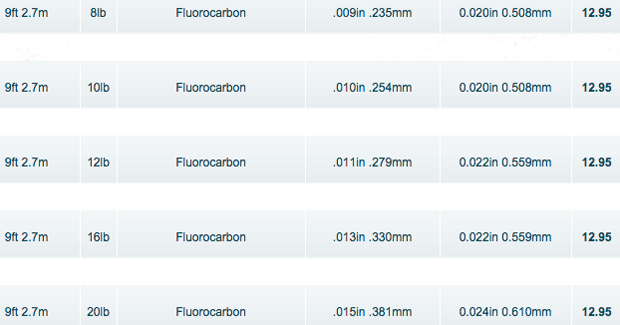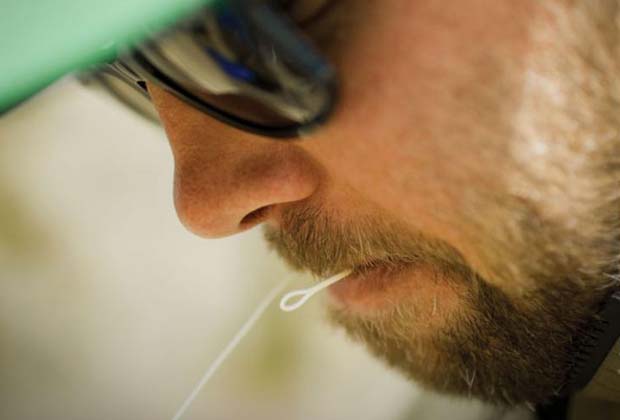Fluorocarbon and monofilament leader – tippet facts as they are today…
[dropcap]W[/dropcap]hat leader materials are best for fly fishing? The answer is a question; how much does a car cost?
Some experts are still trying to fit that 4-pound answer into a 2-pound bucket and what they sometimes opine does little more than confuse us. As a matter of fact, it chases us away from making modern day, useful decisions. Decisions, it turns out, that make the difference between fishing and catching.
Some fly shop personnel voice strong opinions on the subject of leader material and builds – sometimes unwittingly throwing folks off the scent.
As anglers of the fly, we’ve got three choices when it comes to leader material. Actually, make that six: monofilament (mono), bioline (bio), fluorocarbon (fluoro), and brands of each. The latter three a little elusive because mono, bioline and fluoro leader materials are not equally created in each of their own categories (brands). Brand performance of fluoro, like that of mono, varies widely.
Keep it simple…
We’re either fishing surface flies or flies that need to be somewhere below the surface.
If fishing surface flies there’s no discussion necessary – it’s mono or bio.
Below the surface fishing has different variables to consider: depth desired, adding sink tips, bottom debris, hook swims up or down, speed of tidal current or river flow.
Looking through the glass:
1. Fluorocarbon (fluoro) is made from Polyvinylidene Fluoride, or anachronously referred to as PVDF. It’s not new, it’s been around for a long time, but is relatively new as a fishing line. Manufacturers (Japanese) have improved their materials’ fishing performance along the way. Fluoro leader / tippet material of 2000, 2006 or 2008 is not the same as today’s quality.
2. Monofilament (mono) was invented by DuPont in 1939 and marketed successfully as Stren fishing line in the 1950s. It is an extruded single-strand fishing line made from polyamide (nylon) pellets. Now it can be made with a bio-absorbable polymer (bio). Bio was developed in the 1970s for medical use – stitches that dissolve. It is now made for leader and tippet material with the dissolve characteristic intact but modified.
*We’ll discuss bio in a coming post on the impact of fishing line in the environment.
Monofilament’s impact on recreational and commercial fishing communities was atomic. Notably, it was roundly dismissed by expert anglers and narrators of the day because it was too slippery to make knots hold. Sound familiar?
NOTE: There are no made in the U. S. A. leader / tippet material manufacturers. They’re predominantly made in Japan with a few in Germany. U.S. companies are reduced to marking under private labels. Many brands, like the gasoline we buy, are exactly the same – just the label and logo change. Beware of big box store brands. They’re cheap for a reason.
3. With the specific gravity (SG) of water at 1.00, anything with a SG equal to or below 1.00 will float, and anything above 1.00 will theoretically sink. But take into account surface tension, weight of the fly, current and sink it will, but not so fast. Mono has a SG of 1.05 to 1.10. Fluoro is made of more material than mono and thus, much denser / heavier.
Fluoro has less surface tension and thus sinks faster, but not so much so that it’s a wow thing. However, it is better on that score and getting down slightly faster can make a difference, sometimes.
To put SG in perspective: Monel, a nickel-copper alloy has a SG of 8.46 to 8.88 (International Nickel Company). The SG of tungsten, used in high density lines, has a SG of 19.26. Fluoro has a SG of 1.75 to over 1.90.

Seaguar, a Japanese company makes and markets all of its fishing lines with no third party contribution.
4. Cost: Considering only initial cost, mono is clearly the winner over both fluoro and bio. The latter two generally three times the cost.
A 30-yard spool of mono is about $5 and a spool of fluoro about $13 +/-. However, that three year old, unused spool of mono sitting in your bag is not worth using. It’s lost too much of its initial qualities over time. Fluoro knows no such fate. It won’t degrade in the water, sun or trunk your car and its fishable life is many times that of mono, assuming it’s not nicked.
5. Stretch is a measurement that should only be evaluated on leader material when soaked, not dry. Fish are not hooked on dry land. Be wary of that comparison.
Mono absorbs a percentage of its dry weight in water and fluoro absorbs almost no water. The mono wet elongation does not recoil to its dry measurement length after being stretched. Wet, that final recoil length becomes permanent elongation – as much as 30%. And the leader is now smaller in diameter.
For example, a 20-pound-test tippet could now be a 16-pound tippet. That fact is at least a reason to replace used mono tippets and leaders that have been in a tussle. Fluoro has less elasticity (much improved on recently), but will break if stretched beyond 20% and some brands at 30%. Newer products have more elasticity than earlier models, but have similar recoil elongation issues.
6. Fluoro’s surface is substantially harder than mono and therefore far more abrasion resistant. So much so that that could be its best selling feature. Especially so if you fish the flats where break offs are more common because of brush-ups with outcroppings, gill plates, rocks or even temporary tangles with flora and sea bottom. There’s no theory here, fluoro is just flat out better on abrasion resistance.
Fluoro, stretching much less than mono, has proponents heralding its sensitivity – feeling the nibble faster and thus claim more hook-ups. Most anglers interviewed agree with this.
Mono’s champions like its inherent elasticity characteristic, especially tarpon anglers. Some of the top tournament anglers combine mono and fluoro in their leader rigging. Some use a ring to offset the bite through of fluoro line knot-married to mono line, a genuine concern.

RIO Products is one of the brands that sells both knotless leaders and spooled leader lines in both monofilament and fluorocarbon. Knotless fluoro leaders reduce knot requirements on leader builds.
7. The average refractive index of mono is approximately 1.58 and equals 63% of the speed light travels in a vacuum. Fluoro’s index is 1.42, meaning about 70% of the speed it travels in a vacuum.
Fluoro is not theoretically less visible in water than mono, it is less visible and that’s on your side of the ledger. The line diameter also plays into a refractive comparison. The diameter of a 10-pound mono line is thicker than a 10-pound fluoro line and it becomes more dramatic as pound-test increases. However, the invisible claim is pure BS.
8. For break strength, mono is the winner. When wet, mono breaks at about 80% of test at the knot. Fluoro at about 75%. Those numbers don’t lie, but are they significant? Not really. What is most important is the knot maker and the brand.
9. It is well understood that making knots is decidedly more difficult with fluoro because it’s harder, stiffer and slicker when compared to mono. Seating a knot properly is paramount with any leader material.
Summarizing:
Mono has come a long way, even in the last few years by reducing some of its short suits, and its detractors, or gung-ho fluoro folks, seem prone to oversell many of the smaller advantages fluoro has. Buyer beware.
The chemistry of each type of line makes them distinctly different performers in the real world of actually fishing, and that alone is every anglers advantage. Don’t be swayed by hype or the opinions of fulminators. Keep a progressive, open state of mind and you’ll fish mo-betta.









Join the discussion One Comment